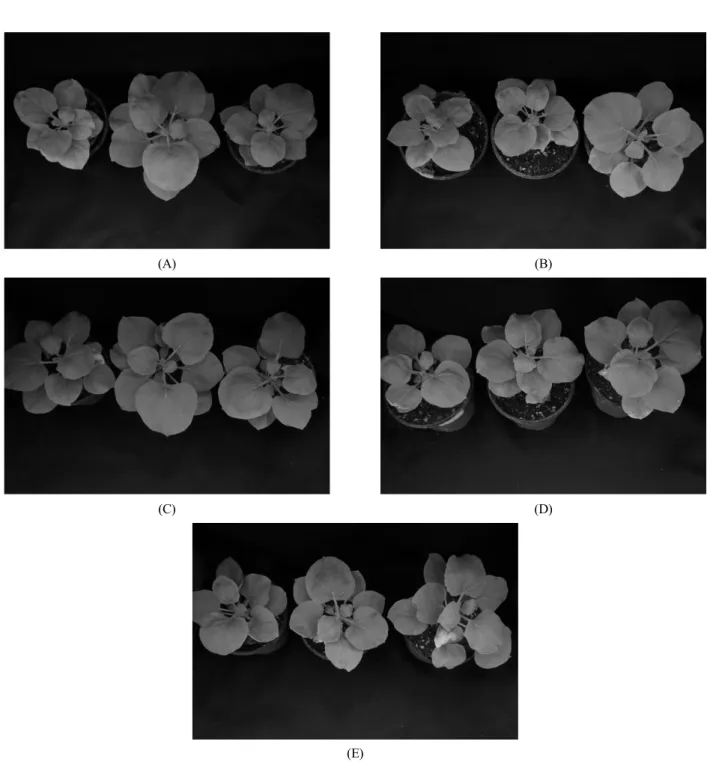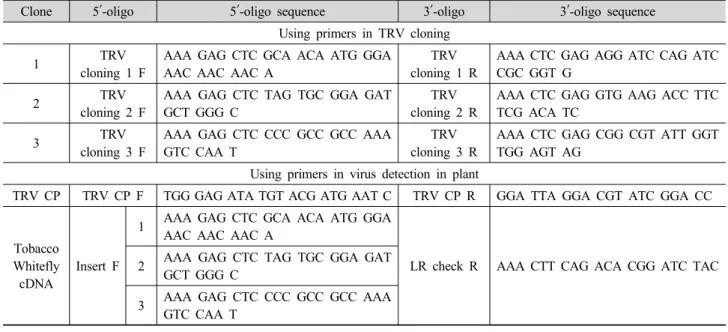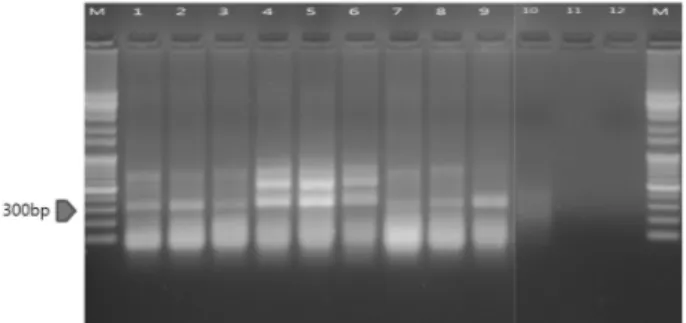RNAi 기법으로 담배가루이 방제를 위해 선발된 유전자의 식물체내 발현
김정희1ㆍ서은영1ㆍ김정규1ㆍ임현섭1ㆍ유용만1ㆍ윤영남1*
충남대학교 농업생명과학대학 응용생물학과
Gene expression in plant according to RNAi treatment of the tobacco whitefly
Jeong-Hee Kim1, Eun-Young Seo1, Jung-Kyu Kim1, Hyoun-Sub Lim1, Yong-Man Yu1, Young-Nam Youn1*
Department of Applied Biology, College of Agriculture and Life Sciences, Chungnam National University, Daejeon, 305-764, Korea Received on 16 June 2015, revised on 23 June 2015, accepted on 24 June 2015
Abstract : Three genes selected from cDNA library of tobacco whitefly, Bemisia tabaci, were checked whether these genes expressed in plant or not, and confirmed the change of gene expression using qRT-PCR in the tobacco whitefly.
First of all, three genes were inserted in Tobacco rattle virus (TRV) RNA2 vector using Sac I and Xho I restriction enzymes, and conducted agro-infiltration in tobacco plants (Nicotiana benthamianana). And then, it was confirmed that TRV RNA2 vector and genes inserted in TRV RNA2 vector were expressed in plant. So, after feeding the tobacco whitefly the plants inoculated the genes and induced RNAi of the genes, we plan to confirm the RNAi in the whitefly and investigate the changes of gene expression through the qRT-PCR.
Key words : Bemisia tabaci, cDNA library, RNAi, TRV VIGS vector, qRT-PCR
*Corresponding author: Tel: +82-42-821-5769 E-mail address: youngnam@cnu.ac.kr
I. 서 론
담배가루이(
Bemisia tabaci
)는 전 세계적으로 발생하며, 600여종 이상의 기주를 가해하는 주요 흡즙성 해충으로 (Perring, 2001), 기주 선호성이나 매개하는 바이러스 등 에 따라 24종의 생태형이 보고되어 있다(Bedford et al., 1994; Burban et al., 1992). 담배가루이는 식물의 체관부 를 흡즙하여 직접적인 피해를 주거나 간접적으로 감로배설 로 인한 그을음병을 유발하고 100종 이상의 바이러스를 매 개하는 등 시설재배 작물의 상품성과 수량에 영향을 준다 (Byrne, 1999; Bedford et al., 1994; Jones, 2003). 특히, 담배가루이에 의해 매개되는 토마토황화위축바이러스인 TYLCV (tomato yellow leaf curl virus)는 전 세계적으로 토마토에 광범위하게 피해를 입히는 바이러스로써, 우리나 라에는 2008년 경상남도 통영에서 처음 발견되었으며, 현 재 전국적으로 확산되어 토마토 농가에 큰 피해를 주고 있다. 담배가루이는 TYLCV의 유일한 매개충으로 알려져 있 다(Czosnek et al., 2002; Lee et al., 2010).
일반적으로 담배가루이는 살충제를 이용하여 방제하지 만, 시설 내에 침입하면 빠르게 피해를 입히고 짧은 세대기 간이 짧아 약제저항성이 발달할 가능성이 높아 방제가 어 렵다(Choi, 1990; Devine and Denholm, 1998; Nauen et al., 2002). 현재까지는 피레스로이드계, 네오니코티노이 드계, 곤충성장조절제(insect growth regulators, IGRs) 계 통 등의 살충제에 대한 약제저항성이 알려져 있다(Horowitz et al., 2005; Karatolos et al., 2012; Lee et al., 2002).
이러한 약제저항성 문제로 인해 미생물농약, 천적, 식물 essential oil, 곤충병원성 곰팡이 등과 같은 생물적 방제방 법이 연구되고 있고(Choi and Kim, 2004; Kim et al., 2008;
Yoon et al., 2010), 최근에는 RNAi기법을 이용한 해충방 제 연구가 많이 이루어지고 있다(Baum et al., 2007; Huvenne and Smagghe, 2010; Whyard et al., 2009). 방제 대상 해충 으로의 dsRNA 전달은 기존에는 직접 injection하는 방법과 dsRNA를 인공먹이에 섞어 섭식시키는 방법이 많이 사용되
어 왔지만(Mutti et al., 2006; Rangasamy and Siegfried, 2012; Sapountzis et al., 2014; Wynant et al., 2014), 위의 두 적용방법 모두 해충방제에 직접 적용하기에 무리가 있 는 방법들이다. 이러한 문제로 인해 최근에는 방제대상 곤 충의 dsRNA를 발현시키는 transgenic plant에 대한 연구가 이루어지고 있다(Bhatia et al., 2012; Mao et al., 2007).
하지만 이 방법 역시 다양한 유전자를 검토해야 하는 RNAi 실험에 이용하기에는 많은 시간과 노동력이 요구되는 문제 가 있다(Ko et al., 2015). VIGS (Virus Induced Gene Silencing) 기법을 이용할 경우 transgenic plant 제작에 비 해 매우 빠르고 효과적으로 유용 유전자를 스크리닝 할 수 있다. 이전 연구에서는 담배가루이에 대한 cDNA library를 제작한 뒤, RNAi 발현 vector인 TRV VIGS vector에 무작 위로 cloning한 뒤 식물에 Agro-infiltration시켜 담배가루 이에게 섭식시킴으로써 유전자 별 방제효과를 검토하였다.
그 결과, RNAi를 통한 방제효과가 있다고 판단되는 유전자 3개를 선발하였다(Ko et al., 2015).
본 연구에서는 선발된 유전자를 이용하여 방제대상 해충 인 담배가루이의 체내에서 RNA interference가 발현되는 여부를 확인하기 위해, 제한효소를 이용한 일반적인 cloning 방법을 통해 유전자를 TRV VIGS vector에 cloning하여 식 물에 Agro-infiltration시킨 후, qRT-PCR를 이용해 이 식물체를 흡즙한 담배가루이의 유전자 발현량 변화를 확인 하여 TRV VIGS vector의 식물체 접종 및 증식 여부와 선발 된 유전자의 식물체내 발현을 검증하고자 한다.
II. 재료 및 방법
1. 공시충과 바이러스
담배가루이(
Bemisia tabaci
)는 25±1℃, 16L:8D, 상대 습도 50~60% 조건의 곤충사육실에서 서광 품종의 토마토 를 기주식물로 하여 계대사육 하였다. TRV(Tobacco rattle virus)는 RNA1, RNA2의 두 개의 genome을 가지며, Liu 등(2002)의 TRV RNA2 VIGS vector를 RNAi 제작에 사용 하였다.2. TRV cloning
Ko 등(2015)의 생물검정을 통해 선발된 유전자들은 효 과검정을 위해, att site가 아닌 multi-cloning site를 가지
는 TRV RNA2 vector에 cloning하였다. 유전자의 sequence 를 토대로 5′과 3′ 말단에 제한효소 Sac I과 Xho I (NEW ENGLAND BioLabs)을 추가하여 제작한 primer (product size 250bp)(Table 1)와 담배가루이 total RNA를 template 로 one step PCR(GeNet Bio)을 이용하여 목표로 하는 유 전자를 증폭하였다. 정제된 PCR 산물과 TRV RNA2 vector 는 각각 SacI과 XhoI으로 37℃에서 digestion한 후, 정제하 여 T4 DNA ligase (Promega)를 이용하여 ligation을 수행 하였다. Ligation 산물은 DH5α
E. coli
competent cell에 transformation하여, Kanamycin(1㎍/ml)을 포함한 LB plate 배지에 200㎕씩 도말하여 배양하였다(37℃, overnight).배지상의 colony는 mini prep.을 통해 plasmid DNA를 추 출, sequencing을 통하여 선발된 유전자의 sequence와 일 치하는지 확인하였다.
3.
Agrobacterium tumefaciens
EHA105 transformationAgro-infiltration을 통해 목적 유전자가 삽입된 TRV를 식물에 접종하고자,
Agrobacterium tumefaciens
EHA 105 competent cell에 plasmid DNA를 transformation하 였다. 목적 유전자가 삽입된 TRV RNA2 vector 3 ㎕와Agrobacterium tumefaciens
EHA 105 competent cell을 섞어 액체질소에 얼린 뒤, 37℃ water bath에서 녹였다.이 과정을 한 번 더 반복한 후, ice에 옮긴 뒤 LB broth 1㎖을 추가하여 30℃에서 2시간 동안 진탕배양하였다. 이 후, Kanamycin(1㎕/㎖)과 Rifampicin(1㎕/㎖)이 포함된 LB plate 배지에 도말한 뒤, 30℃에서 2~3일간 배양 하였 다. Agrobacterium stock cell은 만들어 –80℃에 보관하 였다.
4. 담배(
Nicotiana benthamianana
) Agro- infiltration바이러스 접종을 위해, TRV RNA1, TRV RNA2, TRV RNA2: tobacco whitefly cDNA가 들어있는 Agrobacterium 을 Kanamycin(1 ㎍/㎖)과 Rifampicin(1 ㎕/㎖)이 포함된 LB plate 배지에 streaking하여 30℃에서 1~2일간 배양하 고, 접종할 기주식물인 담배(
Nicotiana benthamianana
) 는 25℃, 16/8(L/D) 조건에서 4주간 생육하였다. Infiltration(A) (B)
(C) (D)
(E)
Fig. 1. Nicotiana benthamiana inoculated (A): negative control, (B): TRV RNA2 original vector, (C): unknown gene 1, (D): unknown gene 2, (E): unknown gene 3.
buffer(10 mM MES, 10 mM MgCl2)에 접종할 Agrobacterium cell을 OD600=0.6으로 현탁하고, Acetosyringone을 150 mM 첨가하였다. 바이러스의 발현을 위해 TRV RNA1과 TRV RNA2 또는 서로 다른 유전자가 cloning된 TRV RNA 2를 동량으로 섞어 주사바늘을 제거한 주사기를 사용하여 잎 뒷면에 접종하였다(Fig. 1).
5. TRV 진단 및 cloning insert확인
식물체 내에서 바이러스 복제와 RNAi발현 여부확인은 TRV 외피단백질(CP)의 PCR을 통해 확인하였다. Trizol reagent(MRC)를 사용하여 담배의 total RNA를 추출한 후, Aqua phenol을 사용하여 total RNA를 정제하였다. 정제한 total RNA는 TRV CP F primer와 TRV CP R primer
Table 1. Primers list used in this study.
Clone 5′-oligo 5′-oligo sequence 3′-oligo 3′-oligo sequence
Using primers in TRV cloning
1 TRV
cloning 1 F
AAA GAG CTC GCA ACA ATG GGA AAC AAC AAC A
TRV cloning 1 R
AAA CTC GAG AGG ATC CAG ATC CGC GGT G
2 TRV
cloning 2 F
AAA GAG CTC TAG TGC GGA GAT GCT GGG C
TRV cloning 2 R
AAA CTC GAG GTG AAG ACC TTC TCG ACA TC
3 TRV
cloning 3 F
AAA GAG CTC CCC GCC GCC AAA GTC CAA T
TRV cloning 3 R
AAA CTC GAG CGG CGT ATT GGT TGG AGT AG
Using primers in virus detection in plant
TRV CP TRV CP F TGG GAG ATA TGT ACG ATG AAT C TRV CP R GGA TTA GGA CGT ATC GGA CC
Tobacco Whitefly cDNA
Insert F
1 AAA GAG CTC GCA ACA ATG GGA AAC AAC AAC A
LR check R AAA CTT CAG ACA CGG ATC TAC 2 AAA GAG CTC TAG TGC GGA GAT
GCT GGG C
3 AAA GAG CTC CCC GCC GCC AAA GTC CAA T
Fig. 2. An electrophoresis of Agro-infiltration in tobacco. It was analyzed TRV RNA2 vector coat protein from 3 genes selected from cDNA library of tobacco whitefly on agarose gel for CP detection. It was confirmed the size about 600bp (positive control coat protein size of 624bp). M: 1kb ladder; Lane 1~9:
3 genes selected from cDNA library of whitefly, Lane 10: TRV RNA2 vector (positive control), Lane 12: negative control.
(Table 1)를 사용하여 one step PCR (GeNet Bio)을 통해 증폭하였다. 증폭한 PCR 산물은 1% agarose gel 상에서 10 ㎕를 100 V, 40분 동안 전기영동 하여 확인하였다. CP 를 통한 바이러스 감염 여부 진단 후, ReverTraAce-α-Ⓡ (ToYoBo)와 random primer, oligo(dT)20를 사용하여 추 출한 total RNA를 template로 하는 cDNA를 합성한 후, 유 전자 sequence를 토대로 제작한 insert F primer와 LR check R primer(Table 1), Primer Taq (GeNet Bio)을 사 용하여 PCR 증폭하였다. PCR 산물은 1% agarose gel 상에 서 10 ㎕를 100 V, 40분 동안 전기영동 하여 확인하였다.
III. 결과 및 고찰
곤충에서의 RNAi 발현을 확인하는 방법에는 다양한 방 법이 있다. 이전의 연구들을 살펴보면 선충의 경우 체색이 투명해지거나 암컷의 형태가 타원형의 방추모양으로 변형 되는 등의 표현형 변화를 통해 확인하거나 뿌리혹과 난낭 수의 변화 및 알의 부화율의 변화를 확인하는 생리·생태적 변화를 통해 RNAi 효과를 확인하고 qRT-PCR을 이용하여 대상 곤충에서의 특정 대상 유전자의 발현량 변화를 확인 하는 분자생물학적인 방법으로 RNAi 효과를 확인하였다 (Fairbairn et al., 2007; Mao et al., 2007). 본 연구의 선행 실험에서는 담배가루이의 성충 발생량과 알·약충수의 발생 량 변화 등 개체군 밀도의 변화로 RNAi 효과를 확인하였고 (Ko and Youn, 2015), 방제효과가 있다고 판단되는 3개의
유전자를 선발하였다. 또한 본 연구에서는 선발된 3개의 유 전자가 식물체 내에서 발현되고 있는지 확인하였다.
먼저, 이전 실험에서 cDNA library의 screening 작업을 통해 선발된 3개의 유전자를 제한효소 Sac I과 Xho I을 이 용해 TRV RNA2 vector에 cloning하였다. 유전자를 cloning 한 TRV는 담배(
N. benthamianana
)에 Agro-infiltration한 후 CP detection을 통해 식물체 내에서의 유전자 발현 유무 를 확인하였다. 그 결과, 유전자와 original TRV를 접종한 담배 sample에서는 600bp 위치에서 band가 확인되었다 (Fig. 2). TRV의 CP size는 약 624bp로, 이를 통해 TRV가 식물체 내에서 발현되고 있는 것을 확인할 수 있었다. CP를 확인한 후에는 TRV에 cloning한 유전자(insert)의 발현 유Fig. 3. An electrophoresis of Agro-infiltration in tobacco. It was analyzed insert from 3 genes selected from cDNA library of tobacco whitefly on agarose gel for insert detection. It was confirmed the size about 300bp (insert size of 250bp). M: 1 kb ladder; Lane 1~9: 3 genes selected from cDNA library of whitefly, Lane 10: TRV RNA2 vector (positive control), Lane 12: negative control.
무를 확인하고자 insert의 forward primer와 vector의 reverse primer를 이용해 insert 부분을 증폭시켰다. 그 결 과, 유전자를 cloning한 TRV를 접종한 담배 sample에서는 300 bp 위치에서 band가 확인되었다(Fig. 3). 이는 진단을 위해 증폭시킨 부분이 250 bp의 insert와 TRV vector의 일부분을 포함하는 것을 감안하면 식물체 내에서 cloning한 유전자 또한 발현되고 있음을 알 수 있다. CP detection과 는 다르게 TRV positive control에서는 어떤 band도 확인 되지 않았는데, 이는 증폭에 사용한 primer 중 insert의 forward primer가 binding되지 않아 진단이 되지 않은 것으 로 판단된다.
IV. 결 론
담배가루이는 600여종의 기주를 광범위하게 가해하는 주요 흡즙성 해충으로, 흡즙으로 인한 피해 뿐만 아니라 TYLCV (Tomato yellow leaf curl virus)를 포함한 100종 이상의 바이러스를 매개한다. 일반적으로 살충제를 이용한 화학적 방제를 하지만 저항성 문제로 인해 어려움을 겪고 있다. 따라서 본 연구에서는 RNAi를 통해 담배가루이를 방 제하기 위해 이전 실험에서 선발한 target gene에 대한 식 물체내에서의 RNAi 발현 효과를 알아보았다. 먼저, 식물체 내에서의 유전자 발현 유무를 확인하고자 유전자를 cloning 한 TRV vector를 담배에 접종하여 TRV의 CP를 detection 하였다. 그 결과, TRV의 CP size인 624 bp와 유사한 600 bp의 위치에서 band가 확인되었고, 이를 통해 식물체 내에 서 TRV가 발현되고 있음을 알 수 있었다. CP detection
후에는 TRV RNA2 vector에 cloning한 유전자도 안정적으 로 발현되고 있는지 확인한 결과, insert를 포함한 증폭시킨 부분의 size와 유사한 300 bp의 위치에서 band가 나타나 삽입된 유전자도 식물체 내에서 발현되고 있는 것을 알 수 있었다. 추후 TRV vector를 통해서 목적 유전자를 접종시 킨 담배를 담배가루이에게 섭식시켜 담배가루이 체내에서 의 RNAi를 유도한 후 qRT-PCR을 통해 유전자 발현량의 변화를 관찰하고자 한다.
감사의 글
본 연구는 2014-2015년도 농림축산식품부 농림수산식 품기술기획평가원의 지원에 의해 수행된 과제입니다(과제 번호: 112018-3).
참 고 문 헌
Baum JA, Bogaert T, Clinton W, Heck GR, Feldmann P, Ilagan O, Johnson S, Plaetinck G, Munyikwa T, Pleau M, Vaughn T, Roberts J. 2007. Control of coleopteran insect pests through RNA interference. Nature Biotechnology, 25:1322-1326.
Bedford ID, Briddon RW, Brown JK, Rosell RC, Markham PG.
1994. Geminivirus transmission and biological characterisation of Bemisia tabaci (Gennadius) biotypes from different geo- graphic regions. Annals of Applied Biology, 125:311-325.
Bhatia V, Bhattacharya R, Uniyal PL, Singh R, Niranjan RS.
2012. Host generated siRNAs attenuate expression of serine protease gene in Myzus persicae. Plos One 7: 10:e46343.
Burban C, Fishpool LDC, Fauquet C, Fargette D, Thouvenel JC. 1992. Host associated biotypes within West African population of the whitefly Bemisia tabaci (Genn.) (Hom.
Aleyrodidae). Journal of Applied Entomology, 113:416-423.
Byrne DN. 1999. Migration and dispersal by the sweet potato whitefly, Bemisia tabaci. Agricultural and Forest Meteorology, 97:309-316.
Choi GM. 1990. Ecology and control of vegetable insect pests.
NIAST. pp. 224.
Choi YM, Kim GH. 2004. Insecticidal activity of spearmint oil against Trialeurodes vaporariorum and Bemisia tabaci adults. Korean Journal of Applied Entomology, 43:323-328.
Czosnek H, Ghanim M, Ghanim M. 2002. The circulative pathway of begomoviruses in the whitefly vector Bemisia tabaci—insights from studies with Tomato yellow leaf curl virus. Annals of Applied Biology, 140:215-231.
Devine GJ, Denholm I. 1998. An unconventional use of piperonyl butoxide for managing the cotton whitefly, Bemisia tabaci (Hemiptera: Aleyrodidae). Bulletin of Entomological Research, 88:601-610.
Fairbairn DJ, Cavallaro AS, Bernard M, Mahalinga-Iyer J, Graham MW, Botella JR. 2007. Host-delivered RNAi: an effective strategy to silence genes in plant parasitic nematodes.
Planta 226:1525-1533.
Horowitz AR, Kontsedalov S, Khasdan V, Ishaaya I. 2005.
Biotypes B and Q of Bemisia tabaci and their relevance to neonicotinoid and pyriproxyfen resistance. Archives of Insect Biochemistry and Physiology, 58:216-225.
Huvenne H, Smagghe G. 2010. Mechanisms of dsRNA uptake in insects and potential of RNAi for pest control: a review.
Journal of Insect Physiology, 56:227-235.
Jones DR. 2003. Plant viruses transmitted by whiteflies.
EEuropean Journal of Plant Pathology, 109:195-219.
Karatolos N, Gorman K, Williamson MS, Denholm I. 2012.
Mutations in the sodium channel associated with pyrethroid resistance in the greenhouse whitefly, Trialeurodes vapo- rariorum. Pest Management Science, 68:834-838.
Kim HY, Lee YH, Kim JH, Kim YH. 2008. Comparison on the Capability of Four Predatory Mites to Prey on the Eggs of Bemisia tabaci (Hemiptera: Aleyrodidae). Korean J. Appl.
Entomol. 47:429-433
Ko NY, Lim HS, Yu YM, Youn YN. 2015a. Construction of cDNA Library for Using Virus-induced Gene Silencing (VIGS) Vector with the Sweetpotato Whitefly, Bemisia tabaci (Hemiptera: Aleyrodidae). Korean Journal of Applied Entomology, 54:91-97.
Ko NY, Youn YN. 2015. Change of population density of tobacco whitefly (Bemisia tabaci, Aleyrodidae, Hemiptera) by RNAi. CNU Journal of Agricultural Sciences, 42:7-13.
Lee H, Song W, Kwak HR, Kim JD, Park JG, Auh CK, Kim DH, Lee KY, Lee SC, Choi HS. 2010. Phylogenetic analysis and inflow route of tomato yellow leaf curl virus (TYLCV) and Bemisia tabaci in Korea. Molecules and Cells, 30:
467-476.
Lee YS, Lee, SY, Park EC, Kim JH, Kim GH. 2002. Com- parative Toxicities of Pyriproxyfen and Thiamethoxam against the Sweetpotato Whitefly, Bemisia tabaci (Homoptera:
Aleyrodidae). Journal of Asia-Pacific Entomology, 5:117-122.
Liu Y, Schiff M, Dinesh‐Kumar SP. 2002. Virus‐induced gene
silencing in tomato. Plant Journal, 31:777-786.
Mao YB, Cai WJ, Wang JW, Hong GJ, Tao XY, Wang LJ, Huang YP, Chen XY. 2007. Silencing a cotton bollworm P450 monooxygenase gene by plant-mediated RNAi impairs larval tolerance of gossypol. Nature Biotechnology, 25: 1307-1313.
Mutti NS, Park Y, Reese JC, Reeck GR. 2006. RNAi knockdown of a salivary transcript leading to lethality in the pea aphid, Acyrthosiphon pisum. Journal of Insect Science, 6. no. 38:1-7
Nauen R, Stump N and Elbert A. 2002. Toxicological and mechanistic studies on neonicotinoid cross resistance in Q type Bemisia tabaci. Pest Management Sience, 58:868-875.
Perring TM. 2001. The Bemisia tabaci species complex. Crop Protection, 20:739-765.
Rangasamy M, Siegfried BD. 2012. Validation of RNA interference in western corn rootworm Diabrotica virgifera virgifera LeConte (Coleoptera: Chrysomelidae) adults. Pest Management Sience, 68:587-591.
Sapountzis P, Duport G, Balman S, Gaget K, Jaubert-Possamai S, Febvay G, Charles H, Rahbe Y, Colella S, Calevro F.
2014. New insight into the RNA interference response against cathepsin-L gene in the pea aphid, Acyrthosiphon pisum: Molting or gut phenotypes specifically induced by injection or feeding treatments. Insect Biochemistry and Molecular Biology, 51:20-32.
Whyard S, Singh AD, Wong S. 2009. Ingested double-stranded RNAs can act as species-specific insecticides. Insect Bio- chemistry and Molecular Biology, 39:824-832.
Wynant N, Santos D, Van Wielendaele P, Vanden Broeck J.
2014. Scavenger receptor‐mediated endocytosis facilitates RNA interference in the desert locust, Schistocerca gregaria.
Insect Molecular Biology, 23:320-329.
Yoon YJ, Yu YM, Lee MH, Han EJ, Hong SJ, Ahn NH, Kim YK, Jee HJ, Park JH. 2010. Characterization of Lecanicillium lecanii Btab0l isolated with bioactivities to tobacco whitefly (Bemisia tabaci). Korean Journal of Applied Entomology, 49:417-422.


